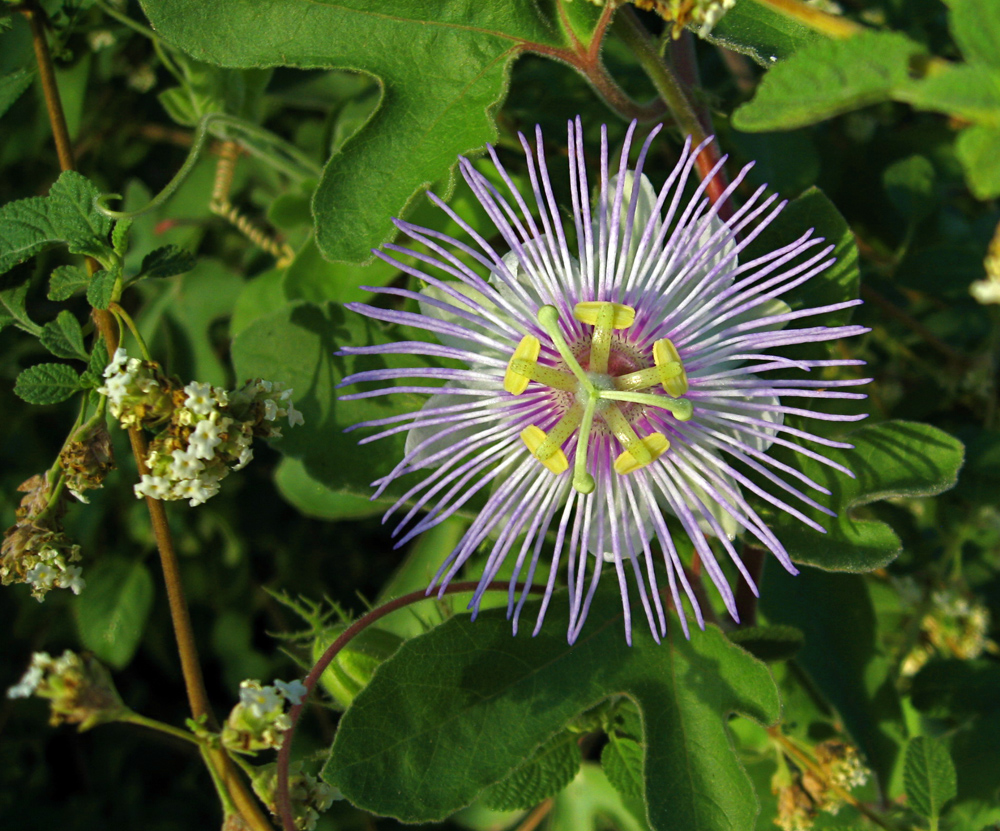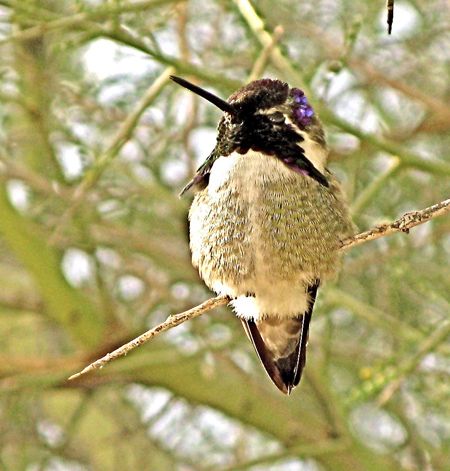Purple in the herbs
Our vegetable garden, like most vegetable gardens, requires continual effort. For the majority of these domesticated types of plants, the desert is not a “shove it in the ground and it will grow” environment. Rabbits and diggy-beaked birds are constantly helping themselves, peak summer heat (now thankfully past) and dryness make frequent watering necessary. So, we pick our battles: tomatoes, no; herbs and chiles, yes.
There are also typical ironies of gardening. Plants that we cannot get to grow in spots we intend for them will flourish as volunteers in the most unlikely and sometimes inconvenient places.
intend for them will flourish as volunteers in the most unlikely and sometimes inconvenient places.
Passiflora foetida (Photo A.Shock) >>
The passionflower, Passiflora foetida, is an example. It will not grow on the fence we’d like it to hide; we’ve tried twice, it’s succumbed three times — once, after a miraculous Lazarus act accomplished by profligate watering, all the re-grown leaves were denuded by Gulf Fritillary caterpillars, which in the plant’s precarious resurgence, finished it off for good. (However, this fall our garden is full of gorgeous orange butterflies). Passionflower will grow untended — unwatered, even — between cracks in the pool deck, and, of course, in the vegetable garden, using the withered and sulky tomatoes as a support. Currently three volunteer passionflower vines (spawned from the beleaguered “lazarus” individual’s seeds) are boisterously and inconveniently twining through our herb garden. We let them; they seem so happy. Above is a photo of one blooming at dawn this morning, growing through another one of our garden success stories, the Mexican oregano, with its less extravagant clusters of tiny white flowers.
garden success stories, the Mexican oregano, with its less extravagant clusters of tiny white flowers.
male Costa’s hummingbird, showing just a glint of purple behind his eye. In the right light, his entire gorget would gleam grape (Photo A.Shock) >>
Whether we get produce to the table or not, the garden is great habitat — young lizards abound, and this morning there was a spiffy male Costa’s hummer gnatting over the oregano, his moustaches way purpler than the lavender Passionflower he hovered over. Periodically he would rest, perching on a wire tomato cage, and sing his thin little wispy song, barely noticeable unless you know to listen for it. It’s their time of year: they seem to be the most numerous hummers in the yard, zipping around from perch to perch, chasing each other, “singing” and establishing their territories. News to interlopers: our garden, rich with suitable perches, flowers and tiny winged insects, is already claimed up.

I’ve been looking for Mexican Oregano to grow, to no avail–any clues for me? I can’t even find a reference to a true botanical name.
Your passionvine is lovely; I think all vines by nature grow where you don’t want them too, or more voraciously than you’d like. Sort of like my Romneya. The ‘eggplant that ate Chicago’.
Sue, I KNEW someone would ask about Mexican oregano, and I didn’t know the Latin name, either! But I found it, the name, at least: Lippia graveolens. It’s not “real” oregano, meaning it’s a new world plant, unlike the Eurasian oraganos we’re familiar with from Italian and Greek cooking. As for getting seeds or plants? I’d suggest an internet search. My trusty Native Seed search is no longer apparently stocking Mexoregano seeds… If you know someone with a plant, you can propagate with soft wood cuttings, they say. Good luck!
I am going to Desert Survivors this weekend to look for volunteers to go into the garden next week. I’ll keep Mexican Oregano in mind.
what an excellent blog entry. With your permission I would like to use it as an example of Made Of Win in our January blogging workshop.
Kate, of course it would please me if you could make use of this post or any other. (But are you sure it’s not more appropriate for a “Made of Wind” blogshop?)
Sue — here’s a link to Mountain Valley Growers, who ship small plants and have Lippia graveolens:
http://www.mountainvalleygrowers.com/lipgraveolens.htm
We often buy their plants at our favorite nurseries here, and I consider them among the best quality plants we can get; high survival rate, accurately identified and labeled, well-grown and planted. Having said that, I’ve never mail-ordered from them, so I don’t know about how that works.
Lippia–who knew. I used to sell a prostrate species of lippia as a rugged bee-friendly ground cover, but haven’t seen it in many years at aretail level.
My guess is that there are several New World genus/species combos that claim the common name of MO, based on flavor profile. In the Caribbena, they use a tropics-friendly Plectranthus species as ‘oregano’. Diana Kennedy describes researching a Mexican herbarium for 13 species used regionally all over Mexico.
Here is a fairly thorough discussion of the different herbs called Mexican Oregano: http://forums.gardenweb.com/forums/load/salvia/msg0822282115179.html
My question: do you cook with your Lippia? Is it satisfactory?
sorry, I leap-frogged over a connection to Poliomentha as MO found at this site: http://www.texasgardener.com/pastissues/janfeb07/SouthHerbs.html
Sue, yes I do use it in the kitchen, in Mexican dishes. It’s very strong, so dried or fresh, you don’t need very much. I love a pinch of it in Pico de Gallo, and I put fresh leaves into beans and stews while they simmer. (For Mediterranean dishes, I use MedO, but will substitute MexO if I’m out of the other.)